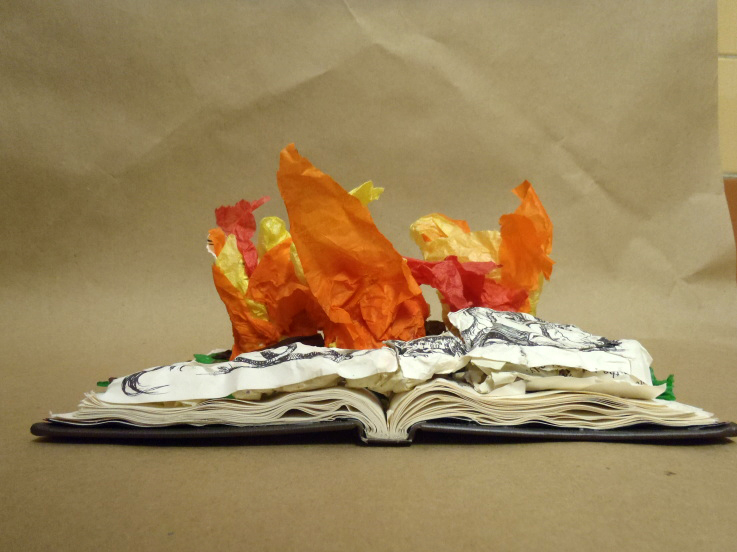
A student’s representation of a fire eating dragon from the lesson “Altered Words,” in which students create sculptures from books. Courtesy of the author.
Words matter. Language is fluid and alive. It soothes, stings, and moves us; it can tap into every human emotion. It is a powerful tool that can be wielded like a sword or whispered like a hint to influence another.
When speaking recently to my friend and fellow Art21 Educator, Don Ball, I asked, “Where do you find happiness?” He responded by saying he prefers to use the word joy over the word happiness because he feels being joyful is more of a state of mind and less of an outside construct that relies on the attainment of things. We then embarked on a conversation about the meaning of these two words, joyfully contemplating the meaning of joy. Why? Words matter. And so does context.
Fred Wilson is a contemporary artist whose practice focuses on curating exhibitions that bring together disparate but related objects. His juxtaposition of art and artifacts of varied purposes and time periods redefines the meanings of the objects. In this context, Wilson unfolds new narratives. He does not rewrite history; he revisits history, specifically Black history, and offers viewers another lens to see it through.
Wilson’s recent exhibition, Afro Kismet at Pace Gallery in New York, was conceived for the fifteenth edition of the Istanbul Biennial. In it, he placed a powerful quote by James Baldwin above a grouping of antique etchings covered in transparent paper, which was strategically cut to reveal the sole Black persons among the Europeans and Turks.
“We all commit our crimes. The thing is to not lie about them—to try to understand what you have done, why you have done it. That way, you can begin to forgive yourself. That’s very important. If you don’t forgive yourself, you’ll never be able to forgive anyone else, and you’ll go on committing the same crimes forever.”
—James Baldwin, Another Country
Wilson’s placement of Baldwin’s text brings another layer into the narrative of Afro Kismet, one that spans time and continents. Written in 1961 and set in 1950s New York City, Baldwin’s novel, Another Country, focused on race and the early civil-rights movement in the United States. In order to complete his work, Baldwin fled to Istanbul to view the racial tensions in the US from afar. Wilson, aware of Baldwin’s relationship to the city, includes the author’s text in the exhibition’s narrative to unravel and re-stitch the threads of history to include a larger worldview that connects us all.
Patrick, grade 6, Locked Up By Bullies. Created as part of the lesson, “In My Own Words,” in which students turn a time they were hurt by words into an artwork. Courtesy of the author.
For an artist, text is a powerful medium, one that can allow meanings to be malleable, and Art21 has featured many artists who use language as a medium. As an educator, I found these artists to be gateways to the expression of my students, whether in conversation or in artwork.
One of my most successful units was a yearlong exploration of text that I implemented with my sixth, seventh, and eighth grades. Students viewed the works of numerous artists who incorporate text, including Glenn Ligon, Barbara Kruger, and Jenny Holzer, as well as word art from popular culture, to consider how words can be used to inspire, incite, and inform.
Engaging the medium of text in different lessons, the students altered books; they illustrated found poems, puns, and figures of speech; they rewrote the news; and they designed protest T-shirts. For the final project, students considered their material and aesthetic preferences in using text to visually define a personal experience of bias or injustice.
Olivia, grade 8, Have I changed enough for you? Created as part of the lesson, “In My Own Words,” in which students turn a time they were hurt by words into an artwork. Courtesy of the author.
In the yearlong curriculum for grades 6, 7, and 8, the unit included five lessons (PDF version):
Lesson 1, “Re-configuring the News”: Students used images and text from newspapers and created collages.
Lesson 2, “Tongue Twisted”: Students illustrated verbs and examples of word play, like puns and figures of speech.
Lesson 3, “Altered Words”: Students created altered books that were then made into sculptures inspired by the stories.
Lesson 4, “Shout, Shout, Let it All Out”: Students designed a
protest/statement t-shirt that focused on an issue they are passionate
about.
Lesson 5, “In My Own Words”: Students created a personal text piece with materials of their choice, based on a time they felt wronged, isolated, or hurt by words.